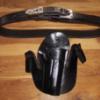Like the answer to most questions: It depends.
I'll look at any project I sew, . . . I really do like the look of stitches being down level in the groove, . . . not up on top of the leather.
If it is a "doable" piece, . . . I'll stitch groove both sides, . . . as I use a Boss also, . . . and no matter what you do, . . . the back side never will look as "pretty" as the front, but having the groove there, . . . AND, . . . working the stitches after sewing, . . . makes to me a better looking product.
Particle is very much correct though, there are sometimes when it just is not worth the gamble of ruining a project.
Grooving on the backside can only work, . . . AFTER, . . . the edges have been very meticulously done. And it would do you well to save scraps of leather and practice edging and grooving and stitching. Whole lot easier to throw away two scraps than an otherwise nice product you messed up sewing.
EDITED: Another thing that will definitely help though, . . . buy or make yourself a little table for the Boss. Mine is nothing more than a 12 in square of high density poly plastic, screwed to some 3/4 in plywood slab legs, with a hole drilled in the end to accept the bobbin area of the machine. It gives me a perfectly flat area to manipulat the piece being sewn, . . . and makes a world of difference in the ease of sewing. It'll also help out if you grooved the back side.
May God bless,
Dwight





